One of the great things about Hawai‘i life is our year-round, near perfect and oh-so-consistent climate. Coupled that with rich, volcanic soil and ample rainfall and we have a year-round growing season. Our climate (and micro-climates) lend us several key advantages. We can condition our indoor air with tradewinds instead of machines, saving on energy costs. With wet and dry microclimates, elevation, and different soil types, we can produce different types of food in the islands, too. Inclement weather doesn’t keep us from walking or riding our bike, instead of driving. Plus, we don’t need to spend money on snow tires, clothes for four seasons, or central heating in winter.
All of this means that we can live a more eco-friendly, sustainable lifestyle here in the islands, especially compared to other places. However, you can still make your daily life more sustainable through small but conscious lifestyle changes. We can all contribute in small ways to reduce our carbon footprint, in order to preserve the beauty of our islands and of our planet for future generations to enjoy. With the cost of fuel and shipping, not to mention the effect of fossil fuels on our environment, keeping it local is just one way to live more sustainably in these remote islands. Here are a few more small and large ways you can live a more sustainable life here in Hawaii.

Hilo Farmers’ Market
Buy Local
When you’re grocery shopping, check out the local farmers’ markets. Almost every major town in Hawaii has at least one market a few days a week. From Hilo to Hanalei, and everywhere in between, you can find local markets serving up delicious, fresh, local fare grown right here in Hawaii. If you mostly shop in-store, seek out the produce from local farms, and the locally made products over imported items.
Support Green Businesses
Many local companies are taking strides to be more eco-friendly – by using biodegradable (or less) packaging, for example, or by having company-wide recycling programs. If you have the choice, buy eco-friendly, local products to support their values as well as the local economy.
Reduce, Reuse, Recycle
Because it’s important! It’s a time-honored way to save waste. Our landfills are filling up quickly and there may come a day where we’ll have nowhere to put our waste. Remember that Hawaii’s Deposit Beverage Container program also pays $.05 for you to turn in your bottles. Use your blue box to recycle glass, plastic, and paper. Buy in bulk at the grocery store for items not available at the market and save on packaging. Dried spices, granola, nuts, and flour are available in the bulk aisle, for example. When you need new furniture or even small utensils, visit antique shops, thrift stores, garage sales or check online for bargains and great used items. Instead of buying new furniture that uses fuel to be shipped here, you can often find great stuff for less.

Recycle symbol on an eco-friendly shopping bag
Donate
Before you throw out old furniture, clothing, sports gear, or books, consider donating it to your local Goodwill or similar charity. We have a homeless crisis here in Hawaii and even those with roofs over their heads often struggle to make ends meet with the high cost of living here. One person’s trash is another person’s treasure, so please take the time to make a donation to help some of our kama‘aina in need.
Stop Using Plastic
Many residents are animal lovers and few creatures are so dear to us, and to our culture, that the sea turtle or honu. A tour of the internet will bring you lots of images of sealife tangled in plastic bags, or those that died from ingesting them. They blow in the wind and tend to end up where they shouldn’t, so just say goodbye to plastic in favor of reusable cloth bags. Leave reusable bags (like this one that supports Sustainable Coastlines Hawai‘i) in your car, by your front door, and in your purse – in convenient places where you won’t forget to bring one along. Equally, ditch the plastic wrap in favor of these pretty, reusable food wraps from Meli, a local company who makes them on Kaua‘i using organic cotton, beeswax, tree resin and plant oils to create a natural antibacterial food wrap.
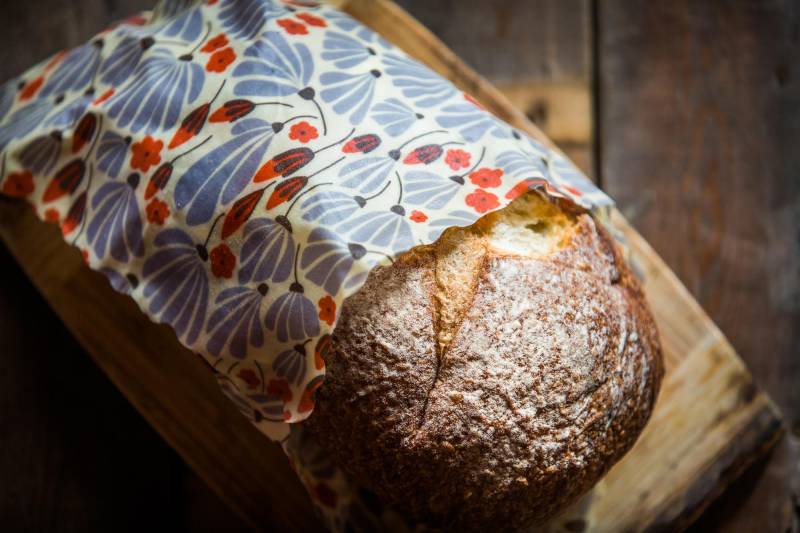
Meli Wrap – reusable, beeswax coated fabric
Use biodegradable and natural products
When you have to buy packaged goods, opt for ones that use biodegradable packaging, to alleviate some of the pressure on our landfills. Lots of companies are opting for rice paper packaging, like local company Hanalei Organic, who use biodegradable packaging for their dried fruit treats. Another option is to seek out companies that recycle their bottles (like shampoo companies) or have refillable bottles and bulk-sized refills packaged in recyclable containers. While they can be slightly more expensive, using soaps without sulfates, phosphates, or other chemicals to wash yourself, your clothes, and your dishes help to keep chemicals out of our groundwater and our water supply.
Buy a Reusable Water Bottle
If you’ve done a beach cleanup lately, you’re probably horrified by the amount of plastic that ends up on our beautiful shores. When the tide is just right, some of our beaches are awash with ocean plastics. Entire organizations have popped up that engage local volunteers in beach clean-up efforts (808 Cleanups is but one of many). But really, it’s a never-ending process because it’s our vast oceans that have been polluted. The plastic just keeps coming! So be the person who gives up plastic water bottles in favor of a good quality, insulated water bottle that’ll last you for years, instead. We have (for now at least) great water quality flowing from our taps, so it’s easy to fill up throughout the day to stay hydrated.
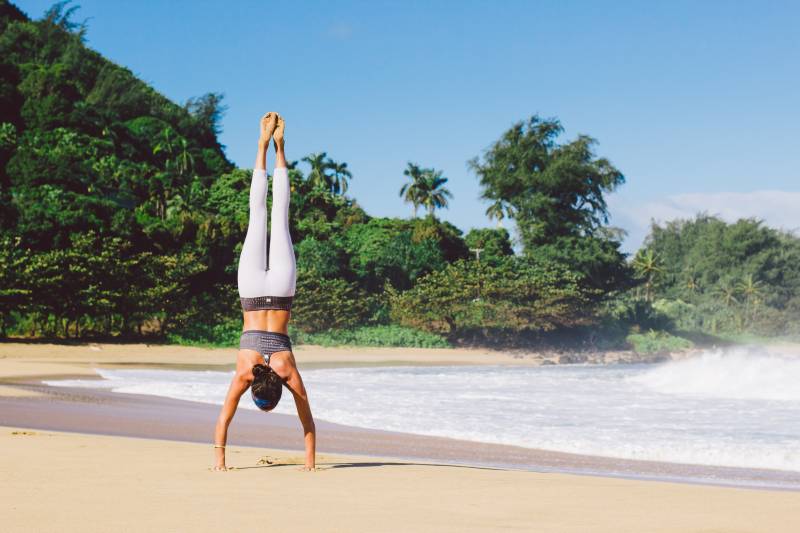
Marla Ben-Dor of Hanalei Organic on the spectacular Garden Isle of Kaua‘i, Photo Credit: Kyle Ikaika Pidot of Pidot Studios
Conserve Water
This can be accomplished in so many ways, but an easy one is to turn off the tap while you’re brushing your teeth. Another is to build a sustainable garden that doesn’t require irrigation. This will also mean less work for you since sustainable landscapes can be planted in your front or backyard and often require less maintenance and care. Lawns aren’t natural to Hawaii, but there are lots of plants that are right at home in here. Choose those or opt for hardscaping to save on your monthly water bill.
Grow Your Own
Backyard gardens are pretty easy to plant and maintain here in Hawaii. If you like to garden, you can grow your own fruits and vegetables, and pick fruit from mature trees in your neighborhood or yard. Check out our recent post on how to start your own backyard farmers’ market or scope out your neighborhood for a community garden, where you can meet other ec0-minded neighbors and garden together. Even schools have added gardening to their curriculum with over 60 school gardening programs on the island and some even incorporating farm-to-lunch programs, according to the Department of Agriculture.
Share With Your Neighbors
Once your garden is grown and harvested, the ‘ohana vibe allows a community of gardeners to trade products with each other so you don’t have to grow everything yourself. Coordinate with neighbors, friends, and family to exchange fresh produce, fruit, and herbs. Extra produce can also be sold at farmer’s markets or donated to local food banks in our community.
Build Habitat
For your garden, choose a variety of native species, which will provide vital habitats for Hawaii’s endemic birds. Stay away from lawns because they are monocultures, usually not native, and use a lot of resources to maintain. The Kona Soil and Water Conservation District has a comprehensive guide to native west side plants. A complete guide to Hawaiian Island native plants can be found at NativePlants Hawaii.
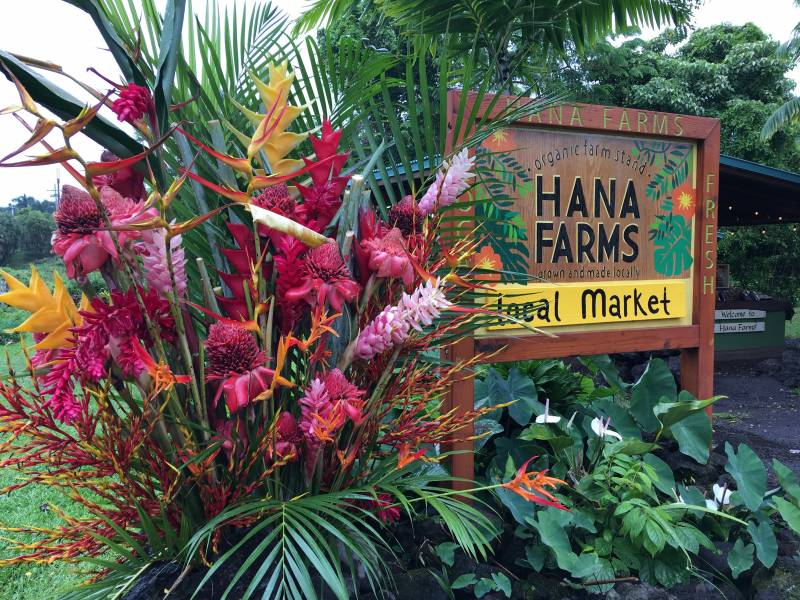
Hana Farms Local Market
Compost
If you live close to the beach and have sandy soil, or have lava rock on your property, it can be tough to make your garden thrive. Green thumbs can get around soil quality obstacles by buying soil or creating their own through compost. There are plenty of effective products out on the market that help curb the smell of compost. There are options for use indoors, like kitchen compost buckets with charcoal filters, or options for outdoor use, like worm farmers or tumblers.
Build Smart
If you plan to build a new home, think about building it in a way that harnesses the trade winds, which can blow through open windows to cool and ventilate your home. A clever floor plan can also maximize the potential for natural light, so you’ll use less electricity throughout the day. If done right, the new home will reduce your use of ceiling fans, air conditioners, and artificial lighting to bring down that your electric bill. While that’s a benefit to you, it’s also a benefit to using less energy, since much of Hawaii energy is currently fossil fuel dependent.
Go Solar
Another popular technique is the installation of solar roof panels that can be used to heat your water or provide supplementary electricity. With such plentiful sunshine year-round, solar panels can help reduce your electric bill by hundreds of dollars. There are still tax credits and rebates available to homeowners looking to go solar, as well as an endless list of quality, reliable solar providers.
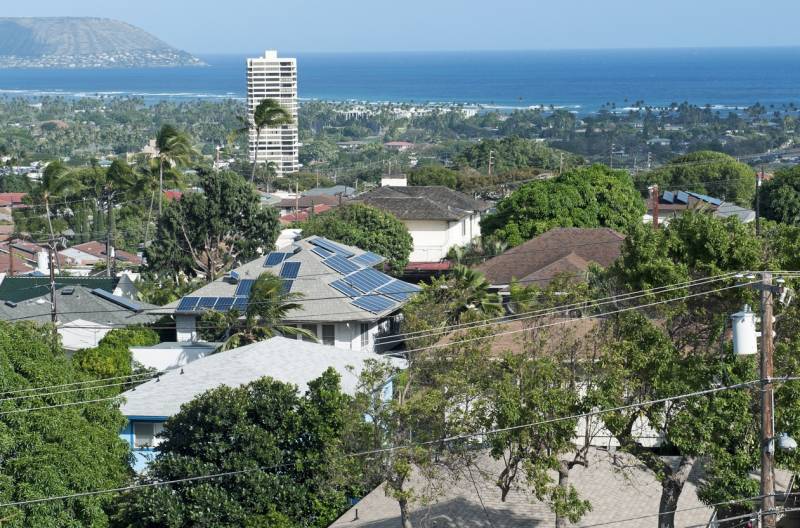
Solar panels on a rooftop in Honolulu, overlooking Koko Crater
Save Energy
Inside your home, remote control electric outlets help to save energy when you’re not at home. They can be set up to shut off power to outlets when you leave the house. You can either designate a master switch, or you can turn off power to your outlets remotely using a phone app. Switching out your light bulbs to energy-saving ones like halogen incandescents, compact fluorescent lamps (CFLs), and light-emitting diodes (LEDs) can save energy and dollars.
Go Veggie or Vegan
Okay, you don’t have to do it every day, but choosing a day (or several days) of the week where you forego animal products is better for you, and better for the plant. Here’s why. Commercially raised animals use resources like crazy – and that means lands, water, and feed. To produce one pound of beef, it requires 2,500 gallons of water. Also, for every burger eaten, it has been estimated that 55 square feet of forest have been destroyed to create grazing land for the cow who produced that beef. Let’s not forget the cow (or chicken or lamb) in this equation. They’ll be grateful for your small lifestyle change. There are lots of great vegetarian options at just about every Hawaii restaurant, and let’s not forget your local farmers’ market as a resource for a day of going veggie.
Go Hybrid or Electric
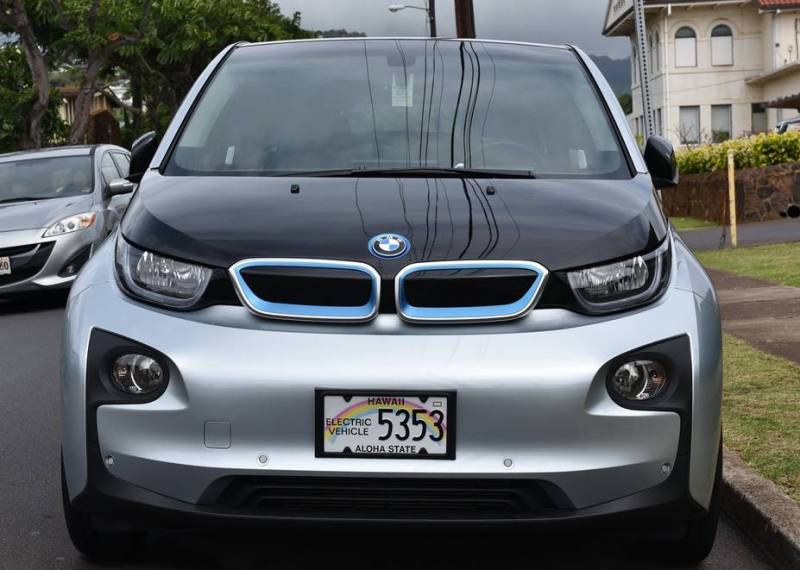
The i3 is BMW’s first zero emissions electric vehicle.
If you find yourself needing a new car, look into electric or hybrid vehicles. Electric charging stations are popping up all over the islands, making all-electric vehicles more convenient and feasible. If you drive a lot, opt for a hybrid vehicle. They are getting about 54 miles to the gallon these days. In Honolulu, electric vehicles benefit from free parking at meters and parking lots often have conveniently located stalls reserved just for electric vehicles.
The state of Hawai‘i has some of the loftiest green energy goals in the country. The Hawaii Clean Energy Initiative has set a goal to switch to 100% renewable energy sources by 2045. We need all the help we can get to reach those goals, so making small changes in your own life can contribute to a better, cleaner Hawaii while also improving your own quality of life.

Quam Properties
November 7, 2017
This is great. Solar panels are the way to go! http://www.quamproperties.com/
Bob
October 3, 2019
THis is kuul